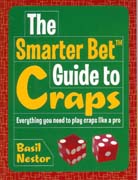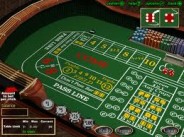ReadyBetGo's Guide to Craps
Craps is About Dice
Basic CrapsCome and Don't Come Craps BetsThe Odds Bet in CrapsCraps Odds SecretsCraps: Working Bets and Taking Bets DownEven More Craps Bets: Place, Lay, BuyBad Craps BetsThe Worst Craps BetsCraps LingoBefore You Go! - Craps Essentials
Smarter Bet Guide to Craps
by Basil Nestor
Some craps bets are good, some are not-so-good, and some are for suckers. The Smarter Bet Guide to Craps separates the best from the rest, and makes craps easy to learn. Everything is here in a clear-cut format: Table layout, dice-shooting techniques, a detailed analysis of every craps bet, and mathematically proven strategies that help lower the casino's advantage. A good basic guide to the game for players who are just starting out.
Club USA Casino Craps
Club USA Casino has good craps action at their site. They offer private, public and reserved tables. The minimum bet is $1 and the max is $500. The casino offers behind the line odds. Nice graphics and sound add up to a satisfying craps experience. Good shooting.
Craps is About Dice
by Basil Nestor
When people think about craps, they often think of a modern invention, the craps table. It’s a monstrously large contraption covered with lines, numbers, and seemingly incomprehensible phrases.
But Basil Nestor is the author of the new Playboy Complete Guide to Casino Gambling. This wonderful book teaches players how to avoid sucker bets and win more when playing gambling games. He is also the author of The Smarter Bet Guide series for video poker, slots, craps, and many other books about gambling. Basil's website is www.smarterbet.com ironically, the contest does not require a table. All you need are dice. One of the reasons why craps has such a long history is that it’s a physically convenient game to play. You can carry the dice in your pocket and play anywhere: on a curb, in the dirt, in a palace, in a foxhole, in a tank, in a submarine…anywhere.
Basil Nestor is the author of the new Playboy Complete Guide to Casino Gambling. This wonderful book teaches players how to avoid sucker bets and win more when playing gambling games. He is also the author of The Smarter Bet Guide series for video poker, slots, craps, and many other books about gambling. Basil's website is www.smarterbet.com ironically, the contest does not require a table. All you need are dice. One of the reasons why craps has such a long history is that it’s a physically convenient game to play. You can carry the dice in your pocket and play anywhere: on a curb, in the dirt, in a palace, in a foxhole, in a tank, in a submarine…anywhere.
 Basil Nestor is the author of the new Playboy Complete Guide to Casino Gambling. This wonderful book teaches players how to avoid sucker bets and win more when playing gambling games. He is also the author of The Smarter Bet Guide series for video poker, slots, craps, and many other books about gambling. Basil's website is www.smarterbet.com ironically, the contest does not require a table. All you need are dice. One of the reasons why craps has such a long history is that it’s a physically convenient game to play. You can carry the dice in your pocket and play anywhere: on a curb, in the dirt, in a palace, in a foxhole, in a tank, in a submarine…anywhere.
Basil Nestor is the author of the new Playboy Complete Guide to Casino Gambling. This wonderful book teaches players how to avoid sucker bets and win more when playing gambling games. He is also the author of The Smarter Bet Guide series for video poker, slots, craps, and many other books about gambling. Basil's website is www.smarterbet.com ironically, the contest does not require a table. All you need are dice. One of the reasons why craps has such a long history is that it’s a physically convenient game to play. You can carry the dice in your pocket and play anywhere: on a curb, in the dirt, in a palace, in a foxhole, in a tank, in a submarine…anywhere.So, let’s forget the table for now. We’ll use it later to help organize the bets. In this section, we’ll talk about the dice.
How Will the Dice Roll?
A standard pair of dice can make thirty-six combinations that total eleven numbers (2 to 12). The table below shows the various possible sequences.
Possible Dice Combinations
|
Number
|
Ways to Roll
|
Combinations
|
True Odds
|
Percent Probability
|
|||||
|
2
|
1
|
1-1
|
35:1
|
2.8%
|
|||||
|
3
|
2
|
1-2
|
2-1
|
17:1
|
5.6%
|
||||
|
4
|
3
|
2-2
|
1-3
|
3-1
|
11:1
|
8.3%
|
|||
|
5
|
4
|
1-4
|
4-1
|
2-3
|
3-2
|
8:1
|
11.1%
|
||
|
6
|
5
|
3-3
|
2-4
|
4-2
|
1-5
|
5-1
|
6.2:1
|
13.9%
|
|
|
7
|
6
|
1-6
|
6-1
|
2-5
|
5-2
|
3-4
|
4-3
|
5:1
|
16.7%
|
|
8
|
5
|
4-4
|
2-6
|
6-2
|
5-3
|
3-5
|
6.2:1
|
13.9%
|
|
|
9
|
4
|
3-6
|
6-3
|
4-5
|
5-4
|
8:1
|
11.1%
|
||
|
10
|
3
|
5-5
|
4-6
|
6-4
|
11:1
|
8.3%
|
|||
|
11
|
2
|
5-6
|
6-5
|
17:1
|
5.6%
|
||||
|
12
|
1
|
6-6
|
35:1
|
2.8%
|
|||||
A pair of dice can create thirty-six possible combinations. Each cube has six sides and 6 x 6 = 36. Percent probabilities in the far right column are rounded.
Let’s say you’re the craps shooter (the person throwing the dice). On your first roll, called the come-out roll, there are two numbers that can win and three that can lose. The winners are 7 and 11. If you roll 7 or 11, the contest is over. You rolled a natural and passed.
If you roll 2, 3, or 12, it’s craps—you don’t pass—you lose, and the contest is over.
Most of the time you won’t roll a natural or craps; the come-out roll will be 4, 5, 6, 8, 9, or 10. When that happens the number becomes your point. You must roll the same number again to pass. There is no limit to the attempts allowed for a pass. You can pass in one roll or one hundred. After a point is established the only way to lose is to roll a 7. Yes, it was good for the come-out, but now it’s bad. All the other numbers (including 11 and craps) have no importance at this stage. Roll the point and you win; roll 7 and you lose. End of contest; the next roll is a come-out.
That’s it. That’s basic craps. Very simple. A winning wager pays 1:1 (even money). The table below shows the various rolls required for a pass and the odds for each outcome.
Note that a come-out roll is twice as likely to pass with a natural than lose with craps. The most likely outcome is establishing a point. Rolling 7 after the come-out (losing) is called a seven-out.
Winning and Losing Rolls for the Shooter
|
Come-Out Roll
|
Numbers
|
Probability of Rolling
|
|
Pass (Win) with Natural
|
7,11
|
22.2%
|
|
Don’t Pass (Lose) with Craps
|
2,3,12
|
11.1%
|
|
Point
|
4,5,6,8,9,10
|
66.7%
|
|
Rolling to Repeat the Point
|
||
|
Pass (Win) with Point
|
Point
|
8.3% to 13.9%
|
|
Don’t Pass (Lose) with Seven
|
7
|
16.7%
|
|
No Effect
|
All other numbers
|
69.4% to 75%
|
A come-out roll is twice as likely to pass with a natural than lose with craps. The most likely outcome is establishing a point. If a point is established, the shooter must roll the point again to pass. The shooter loses if he rolls 7 before repeating the point.
Of course, there is much more to craps than pass and don’t pass, but it’s mostly about the shooter and this contest. If you understand how to pass, you understand craps.
Wagers on pass have a house edge of 1.41%. In other words, the casino will earn an average of $14 for every $1,000 you bet. That’s not bad when you consider that the casino provides the table, the crew, and a palatial atmosphere. Just the smallest amount of luck can easily push you into the plus column.
Pass vs. Don’t Pass
Strict regulations these days insure that craps games are honest, no loaded dice and no hanky-panky. But in the old days when you had to knock on a door and whisper a password to play craps, the integrity of the game wasn’t always so absolute. What could you do if you didn’t trust the shooter’s dice? The obvious solution was to bet against the shooter. That option is still available to this day.
A wager on don’t pass is essentially the reverse of betting on pass; naturals (7 or 11) lose on the come-out. Craps wins (with one exception). Making the point loses. Seven-out wins.
The one exception is 12 on the come-out. It’s a push. No money changes hands. That’s the casino’s entire advantage. If 12 wasn’t a push, then you could earn 1.41 percent just like the house. A push on the 12 shifts the edge to the opposite side, and it gives the casino an advantage of 1.36 percent on the don’t pass (from here forward we’ll round this number to the nearest tenth, 1.4 percent).
Some casinos “bar the two” instead of the 12 on don’t-pass wagers. Changing the push from 12 to 2 has no effect on the house edge or the overall probability of winning.
This yin-yang do-don’t structure is repeated throughout the game of craps. Most of the bets can be played on both sides. Some people use the terms “right” or “wrong” when describing these wagers. Others say that “do” bettors are “against the house” and “don’t bettors” are “with the house.” Such phrases aren’t quite accurate, but you will hear them from time to time. Just remember that the house has an edge both ways. It might be psychologically upsetting for some people to see other players betting “against” them, but it’s really no worse than betting red when someone else bets black at roulette. The house covers both wagers.
The preceding material is just a sample of what you'll find in Basil Nestor's Smarter Bet Guide to Craps.
[ learn more craps! ]

